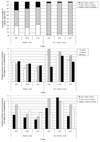1. Sinden R, Gilles H. Warrell D, Gilles H, editors. The malaria parasites. Essential malariology. 2002. 4th ed. London: Arnold;8.
2. Sachs J, Malaney P. The economic and social burden of malaria. Nature. 2002. 415:680–685.

3. Jeon JH. Outline of acute infectious diseases in Korea. 1975. Seoul: Choishin-euihak;28–34.
4. Hasegawa Y. Malaria in Korea. J Chosen Med Soc. 1913. 4:53–69.
5. Hasegawa Y. On the malaria endemicity in Kangnung. area in Kangwon-do. Mansen No Ikai. 1926. 62:59–66.
6. Kobayashi H. Review on malaria and Anopheles in Korea. J Chosen Med Soc. 1932. 22:107–111.
7. Hale TR, Halpenny GW. Malaria in Korean veterans. Can Med Assoc J. 1953. 68:444–448.
8. Hankey DD, Jones R Jr, Coatney GR, Alving AS, Coker WG, Garrison PL, Donovan WN. Korean vivax malaria I. Natural history and response to chloroquine. Am J Trop Med Hyg. 1953. 2:958–969.
9. Alving AS, Hankey DD, Coatney GR, Jones R Jr, Coker WG, Garrison PL, Donovan WN. Korean vivax malaria II. Curative treatment with pamaquine and primaquine. Am J Trop Med Hyg. 1953. 2:970–976.
10. Coatney GR, Alving AS, Jones R Jr, Hankey DD, Robinson DH, Garrison PL, Coker WG, Donovan WN, Di Lorenzo A, Marx RL, Simmons IH. Korean vivax malaria V. Cure of the infection by primaquine administered during long-term latency. Am J Trop Med Hyg. 1953. 2:985–988.
11. Jones R Jr, Jackson LS, Di Lorenzo A, Marx RL, Levy BL, Kenny EC, Gilbert M, Johnston MN, Alving AS. Korean vivax malaria III. Curative effect and toxicity of primaquine in doses from 10 to 30 mg. daily. Am J Trop Med Hyg. 1953. 2:977–982.
12. Ministry of Health and Society. Report of Malaria eradication project 1959-1962. 1963. Seoul: Ministry of Health Society.
13. Park JW, Klein TA, Lee HC, Pacha LA, Ryu SH, Yeom JS, Moon SH, Kim TS, Chai JY, Oh MD, Choe KW. Vivax malaria: a continuing health threat to the Republic of Korea. Am J Trop Med Hyg. 2003. 69:159–167.

14. Moon JJ, Cho SY. Incidence patterns of vivax malaria in civilians residing in a high-risk county of Kyonggi-do (province), Republic of Korea. Korean J Parasitol. 2001. 39:293–299.

15. Yeom JS, Ryu SH, Oh S, Lee WJ, Kim TS, Kim KH, Kim YA, Ahn SY, Cha JE, Park JW. Status of Plasmodium vivax malaria in the Republic of Korea during 2001-2003. Am J Trop Med Hyg. 2005. 73:604–608.

16. Yeom JS, Kim TS, Oh S, Sim JB, Barn JS, Kim HJ, Kim YA, Ahn SY, Shin MY, Yoo JA, Park JW. Plasmodium vivax malaria in the Republic of Korea during 2004-2005: changing patterns of infection. Am J Trop Med Hyg. 2007. 76:865–868.

17. Yeom JS, Ryu SH, Oh S, Choi DH, Song KJ, Oh YH, Lee JH, Kim YA, Ahn SY, Yang HY, Cha JE, Park JW. Evaluation of anti-malarial effects of mass chemoprophylaxis in the Republic of Korea army. J Korean Med Sci. 2005. 20:707–712.

18. Korea Centers for Disease Control and Prevention. Annual report of malaria elimination project in 2006. 2006. Seoul: Korea Centers for Disease Control and Prevention.
19. Korea Centers for Disease Control and Prevention. Guide for the control of infectious diseases. 2007. Seoul: Korea centers for disease control and prevention.











 PDF
PDF ePub
ePub Citation
Citation Print
Print




 XML Download
XML Download